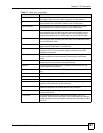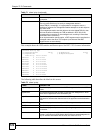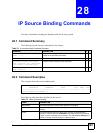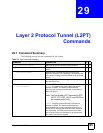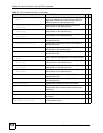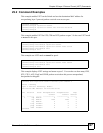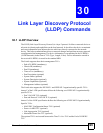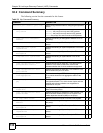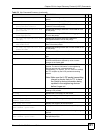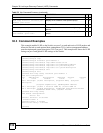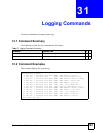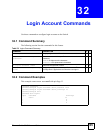
Ethernet Switch CLI Reference Guide
129
CHAPTER 30
Link Layer Discovery Protocol
(LLDP) Commands
30.1 LLDP Overview
The LLDP (Link Layer Discovery Protocol) is a layer 2 protocol. It allows a network device to
advertise its identity and capabilities on the local network. It also allows the device to maintain
and store information from adjacent devices which are directly connected to the network
device. This helps an administrator discover network changes and perform necessary network
reconfiguration and management. The device information is encapsulated in the LLDPDUs
(LLDP data units) in the form of TLV (Type, Length, Value). Device information carried in
the received LLDPDUs is stored in the standard MIB.
The Switch supports these basic management TLVs.
• End of LLDPDU (mandatory)
• Chassis ID (mandatory)
• Port ID (mandatory)
• Time to Live (mandatory)
• Port Description (optional)
• System Name (optional)
• System Description (optional)
• System Capabilities (optional)
• Management Address (optional)
The Switch also supports the IEEE 802.1 and IEEE 802.3 organizationally-specific TLVs.
Annex F of the LLDP specification defines the following set of IEEE 802.1 organizationally
specific TLVs:
• Port VLAN ID TLV (optional)
• Port and Protocol VLAN ID TLV (optional)
Annex G of the LLDP specification defines the following set of IEEE 802.3 Organizationally
Specific TLVs:
• MAC/PHY Configuration/Status TLV (optional)
• Power via MDI TLV (optional)
• Link Aggregation TLV (optional)
• Maximum Frame Size TLV (optional)
The optional TLVs are inserted between the Time To Live TLV and the End of LLDPDU
TLV.



